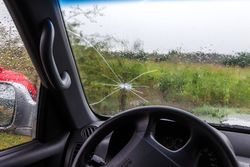What Following Distance Should Drivers Maintain?

It can be frustrating to get stuck behind a slow driver when you’re in a hurry. While you may be tempted to travel closely to prompt someone to pay attention or drive at the speed limit, tailgating is against the law, and for good reason. The practice could damage auto glass and puts drivers at risk. Use the guide below to protect your family and vehicle.
Why Should You Avoid Tailgating?
Tailgating means driving closely behind another car. When you don’t leave enough space between your vehicle and the one ahead of you, you may not have enough time to avoid a collision if the other car suddenly brakes. A driver who leaves less than a 2-second break between them and another vehicle is at a heightened risk for rear-end collisions, which make up around 40% of all crashes.
 Additionally, road debris, litter, and gravel can fly into your vehicle, damaging the auto glass or car body. Maintaining longer distances helps you avoid any particles that get kicked up.
Additionally, road debris, litter, and gravel can fly into your vehicle, damaging the auto glass or car body. Maintaining longer distances helps you avoid any particles that get kicked up.
What Are Some Safe Following Distances to Maintain?
As a rule of thumb, travel at least three seconds behind another vehicle on city roads and highways. To maintain this distance, pick a fixed point near the road, such as a street sign. Start counting when the vehicle in front of you passes it. You should count to at least three before driving past the same landmark.
When driving behind commercial trucks and during periods of inclement weather, increase the traveling distance to five seconds.
Anytime you notice a chip or crack in your car windows or windshield, turn to the team at Expert Auto Glass in Riverton, UT. Serving Salt Lake County, these trusted professionals have provided quality auto glass repair and replacement since 2006. With mobile service available at no additional cost, they make it easy to keep your vehicle in top shape. Learn more about how they will help by visiting their website, or call (801) 569-2666 to schedule an appointment.
About the Business
Have a question? Ask the experts!
Send your question

